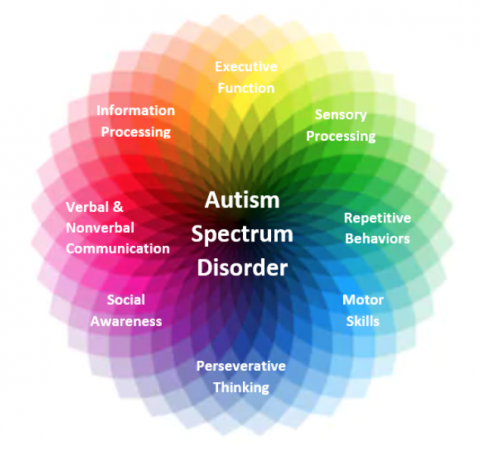Addressing Usual Myths: What You Need To Understand About Autism Today
Addressing Usual Myths: What You Need To Understand About Autism Today
Blog Article
Discovering Autism: Approaches for Effective Communication and Interaction
Efficient communication and communication with individuals on the autism range necessitate a thorough understanding of their special needs and choices. The complexities of these strategies expose additional factors to consider that warrant exploration, specifically in how they can be adapted to individual experiences and varied contexts.
Understanding Autism Spectrum Problem
Autism Spectrum Condition (ASD) encompasses a series of neurodevelopmental problems defined by obstacles in social interaction, interaction, and repetitive habits. The term "range" reflects the varied indications and varying degrees of severity experienced by individuals with ASD. While some might exhibit considerable problems, others might display high-functioning characteristics, permitting higher self-reliance in day-to-day live.
The beginning of ASD commonly takes place in early childhood years, with indications frequently well-known by age two. Very early signs might consist of postponed speech development, restricted eye get in touch with, and troubles in recognizing social cues. The precise etiology of ASD continues to be uncertain, research study recommends a combination of genetic and ecological aspects plays an important role in its advancement.
As a result, treatments and support customized to private needs are crucial for cultivating communication and social abilities. Acknowledging the intricacy of ASD is crucial for promoting recognition, acceptance, and reliable methods that facilitate purposeful interactions with people on the spectrum.

Importance of Clear Interaction
Reliable interaction is important for fostering understanding and link, specifically for individuals with Autism Range Condition (ASD) Clear interaction not only facilitates social communications yet likewise enhances the person's capacity to reveal their feelings, requirements, and ideas. For people with ASD, the nuances of language can typically be challenging; consequently, utilizing unambiguous and uncomplicated language is crucial.
Furthermore, clear communication assists reduce disappointment and anxiousness that might occur from misconceptions. When messages are conveyed in a regular and direct fashion, individuals with ASD are much better geared up to analyze details properly, which can dramatically improve their social involvement and participation in different settings.
Establishing routines and making use of visual assistances can further bolster clear communication. These methods offer people with foreseeable frameworks that help understanding and retention of information. Furthermore, proactively being and paying attention person during interactions advertises an encouraging environment where individuals with ASD feel valued and comprehended.
Inevitably, focusing on clear communication not only equips people with ASD yet likewise fosters more meaningful connections with their peers, caretakers, and the broader area, paving the way for collective partnerships and comprehensive communications. - autism
Non-Verbal Interaction Techniques
Communication prolongs beyond words, and for people with Autism Range Problem (ASD), non-verbal signs play a substantial duty in communications. Non-verbal interaction strategies can consist of faces, motions, body movement, and eye call, every one of which function as essential parts for sharing intentions and feelings.
Recognizing and analyzing these non-verbal signals can boost communications with people with ASD. For example, a cozy smile or open position can produce a welcoming atmosphere, urging engagement. Likewise, utilizing visual aids-- such as image cards or signs-- can bridge communication voids and assist share messages better.
It is also important to be mindful of individual space, as individuals with ASD might have different convenience levels pertaining to distance. Observing their responses to physical closeness can educate proper adjustments.

Developing Helpful Environments
Developing a helpful environment is crucial for promoting positive communications and improving the well-being of people with Autism Spectrum Problem (ASD) Such atmospheres can substantially decrease anxiousness and develop a feeling of safety and security, permitting individuals to express themselves a lot more freely.
To attain this, it is vital to think about sensory level of sensitivities that individuals with ASD may experience. Modifying the physical area to include soft illumination, minimal background sound, and comfortable seats can create a relaxing ambience. Furthermore, making use of consistent regimens and clear visual routines can assist individuals expect changes and decrease unpredictability, further advertising convenience.
Social areas need to be structured to reduce frustrating stimuli while offering possibilities for engagement in preferred tasks. Facilitating areas assigned for silent time can also offer as a haven throughout minutes of tension. Significantly, including elements of choice equips people, permitting them to work out agency in their environment.

Urging Social Interactions
Cultivating social interactions amongst individuals with Autism Range Disorder (ASD) calls for intentional approaches that prioritize convenience and engagement. Establishing predictable routines can aid decrease anxiousness, making social settings much more friendly. Creating structured settings with defined obligations and duties permits individuals to engage without the frustrating stress of unstructured social characteristics.
Including interests and staminas right into social tasks can work as a driver for communication. Arranging group activities around shared pastimes or subjects of attraction can promote all-natural conversations and connections. Additionally, using visual assistances, such as social manuscripts or pictorial routines, can assist in understanding social cues and expectations.
Modeling proper social habits is critical - autism. Adults and peers should demonstrate their explanation efficient interaction strategies, consisting of energetic listening and turn-taking. Role-playing circumstances can additionally provide a safe space for individuals to practice these skills
Finally, Going Here promoting peer connections with inclusive practices is vital. Motivating inclusive playdates or group outings can develop possibilities for socializing in a comfy setting. By executing these caretakers, techniques and educators can significantly boost social interactions for individuals with ASD, advertising their general social advancement and well-being.
Final Thought
Finally, reliable communication and communication techniques are vital for sustaining individuals with Autism Range Disorder. Emphasizing clear language, including non-verbal cues, and developing predictable routines dramatically improve involvement and decrease anxiousness. Creating helpful settings fosters secure social interactions, while motivating shared passions helps with purposeful connections. Eventually, these approaches empower individuals with autism to browse social landscapes, advertising their overall wellness and making it possible for the development of long lasting partnerships.
Effective communication and interaction with individuals on the autism spectrum require a detailed understanding of their one-of-a-kind needs and choices. Clear communication not only helps with social interactions however likewise improves the individual's ability to express their ideas, emotions, and needs.Cultivating social communications amongst individuals with Autism Spectrum Problem (ASD) calls for willful strategies that prioritize convenience and involvement. By applying these techniques, educators and caregivers can significantly enhance social communications for individuals with ASD, advertising their total social growth and wellness.
In conclusion, reliable communication and interaction methods are vital for supporting people with Autism Spectrum Disorder.
Report this page